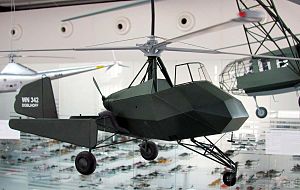Doblhoff WNF 342
| Doblhoff/WNF 342 | |
|---|---|

| |
| Doblhoff WNF 342 V4 model in the Hubschraubermuseum Bückeburg (Helicopter Museum Bückeburg) | |
| Role | Tip jet research helicopter |
| National origin | Austria |
| Manufacturer | Wiener-Neustädter Flugzeugwerke |
| Designer | Friedrich von Doblhoff |
| First flight | 1943 |
| Number built | 3 |
The Doblhoff/WNF 342 was the first helicopter to take off and land using tip jets to drive the rotor.
Development[]
The WNF 342 was designed for a German Navy requirement for an observation platform for use from small ships and submarines.[1]
The conventional piston engine drove both a small propeller (to provide airflow across a rudder) and an air compressor to provide air (subsequently mixed with fuel) through the rotor head and hollow rotor blades to combustion chambers at the rotor tips.[2]
Variants[]
V1/V2: The first helicopter was initially powered by a 60 horsepower (45 kW) engine (V1) and then a 90 horsepower (67 kW) engine (V2)—both by Walter Mikron. It first flew in 1943,[3] and was captured with V4 at Zell am See.
V3: The second WNF 342 had a larger rotor and was destroyed during testing.

V4: The last unit produced was a two-seat variant with new collective and cyclic controls.[clarification needed] After 25 flight hours it was captured by United States forces[4] and on July 19, 1945, shipped to the US under Operation Lusty on HMS Reaper (D82).[1]
Specifications (V4)[]
Data from Illustrated Encyclopedia of Aircraft[3]
General characteristics
- Crew: 2
- Empty weight: 430 kg (948 lb)
- Gross weight: 640 kg (1,411 lb)
- Powerplant: 1 × BMW-Bramo Sh.14A radial piston engine , 104 kW (140 hp)
- Main rotor diameter: 10.00 m (32 ft 9.75 in)
- Main rotor area: 78.54 m2 (845.42 sq ft)
Performance
- Maximum speed: 48 km/h (30 mph, 26 kn)
See also[]
Related lists
References[]
- ^ "Doblhoff". Hubschrauber Museum. Retrieved 2016-04-14.
- ^ Ford, Roger (2013). Germany's Secret Weapons of World War II. London, United Kingdom: Amber Books. p. 224. ISBN 9781909160569.
- ^ Jump up to: a b Orbis 1985, pp. 1454–1455
- ^ Apostolo, Giorgio. The Illustrated Encyclopedia of Helicopters, pp. 18, 126. Bonanza Books, New York, 1984. ISBN 0-517-43935-2.
- The Illustrated Encyclopedia of Aircraft (Part Work 1982–1985). Orbis Publishing.
- Vertical Rewind: Spoils of War
External links[]
- 1940s Austrian experimental aircraft
- 1940s Austrian helicopters
- Aircraft first flown in 1943
- Wiener Neustadter aircraft
- Tipjet-powered helicopters
- Single-engined piston helicopters